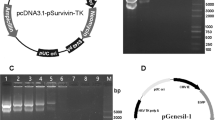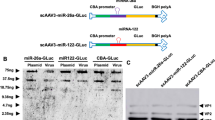Abstract
We constructed a novel hepatocellular carcinoma-specific conditionally replicative adenovirus (CRAd). This adenovirus, designated Ad.HS4.AFP.E1A/TRAIL, expresses E1A to mediate viral replication and TRAIL to enhance HCC-killing efficacy under the control of a modified AFP promoter. An insulator HS-4 was placed in front of the AFP promoter to enhance the fidelity of the heterologous promoter. This virus was shown to have specific cytolytic activity in AFP-expressing HCC cells in vitro. Furthermore, the replication efficiency of Ad.HS4.AFP.E1A/TRAIL correlated well with AFP expression of the host cells, showing a 100-fold and 1 000 000-fold decrease in the low-and non-AFP-expressing HCC cells, respectively, compared to the high AFP-expressing HCC cells. An increase in mRNA of TRAIL and the elevated Caspase-3 activity were also observed in Ad.HS4.AFP.E1A/TRAIL-infected HCC cells. These results indicated that TRAIL expression from the viral vector activated the Caspase-3 enzymatic capacity and the HCC cells were sensitive to TRAIL. In vivo, Ad.HS4.AFP.E1A/TRAIL effectively prevented the growth of low AFP-expressing BEL-7404 xenografts. These results indicate that Ad.HS4.AFP.E1A/TRAIL could provide a new strategy of gene therapy for HCC.
This is a preview of subscription content, access via your institution
Access options
Subscribe to this journal
Receive 12 print issues and online access
$259.00 per year
only $21.58 per issue
Buy this article
- Purchase on Springer Link
- Instant access to full article PDF
Prices may be subject to local taxes which are calculated during checkout







Similar content being viewed by others
Abbreviations
- CRAd:
-
conditionally replicative adenovirus
- IRES:
-
internal ribosome entry site
- HCC:
-
hepatocellular carcinoma
- AFP:
-
α-fetoprotein
- TNF:
-
tumor necrosis factor
- TRAIL:
-
TNF-related apoptosis inducing ligand
- MTS:
-
3-(4, 5-dimethylthiazol-2-yl)-5-(3-carboxymethoxyphenyl)-2-(4-sulfophenyl)-2H-tetrazolium
- MOI:
-
multiplicity of infection
- PFU:
-
plaque-forming units
- RT-PCR:
-
reverse transcrption-PCR
- CAR:
-
coxsackie-adenovirus receptor
- Ad5.WT:
-
wild-type adenovirus 5
- CPE:
-
cytopathic effect
- DDP:
-
cis-diamminedichloroplatinum
References
Zhu AX . Hepatocellular carcinoma: are we making progress? Cancer Invest 2003; 21: 418–428.
Llovet JM, Beaugrand M . Hepatocellular carcinoma: present status and future prospects. J Hepat 2003; 38: 136–149.
Hallenbeck PL, Chang YN, Hay C, Golightly D, Stewart D, Lin J et al. A novel tumor-specific replication-restricted adenoviral vector for gene therapy of hepatocellular carcinoma. Hum Gene Ther 1999; 10: 1721–1733.
Tangkijvanich P, Anukulkarnkusol N, Suwangool P, Lertmaharit S, Hanvivatvong O, Kullavanijaya P et al. Clinical characteristics and prognosis of hepatocellular carcinoma: analysis based on serum alpha-fetoprotein levels. J Clin Gastroenterol 2000; 31: 302–308.
Camper SA, Tilghman SM . The activation and silencing of gene transcription in the liver. Biotechnology 1991; 16: 81–87.
Nakabayashi H, Hashimoto T, Miyao Y, Tjong KK, Chan J, Tamaoki T . A position-dependent silencer plays a major role in repressing alpha-fetoprotein expression in human hepatoma. Mol Cell Biol 1991; 11: 5885–5893.
Ohashi M, Kanai F, Tateishi K, Taniguchi H, Marignani PA, Yoshida Y et al. Target gene therapy for a-fetoprotein-producing hepatocellular carcinoma by E1B55k-attenuated adenovirus. Biochem Biophys Res Commun 2001; 282: 529–535.
Li Y, Yu DC, Chen Y, Amin P, Zhang H, Nguyen N et al. A hepatocellular carcinoma-specific adenovirus variant, CV890, eliminates distant human liver tumors in combination with doxorubicin. Cancer Res 2001; 61: 6428–6436.
Steinwaerder DS, Lieber A . Insulation from viral transcriptional regulatory elements improves inducible transgene expression from adenovirus vectors in vitro and in vivo. Gene Ther 2000; 7: 556–567.
Yamamoto M, Davydova J, Takayama K, Alemany R, Curiel DT . Transcription initiation activity of adenovirus left-end sequence in adenovirus vectors with e1 deleted. J Virol 2003; 77: 1633–1637.
Ye X, Liang M, Meng X, Ren X, Chen H, Li ZY et al. Insulation from viral transcriptional regulatory elements enables improvement to hepatoma specific gene expression from adenovirus vectors. Biochem Biophics Res Commun 2003; 307: 759–764.
Kim K, Fisher MJ, Xu SQ, el-Deiry WS . Molecular determinants of response to TRAIL in killing of normal and cancer cells. Clin Cancer Res 2000; 6: 335–346.
Walczak H, Miller RE, Ariail K, Gliniak B, Griffith TS, Kubin M et al. Tumoricidal activity of tumor necrosis factor-related apoptosis-inducing ligand in vivo. Nat Med 1999; 5: 157–163.
Pan G, O'Rourke K, Chinnaiyan AM, Gentz R, Ebner R, Ni J et al. The receptor for the cytotoxic ligand TRAIL. Science 1997; 276: 111–113.
Walczak H, Degli-Esposti MA, Johnson RS, Smolak PJ, Waugh JY, Boiani N et al. TRAIL-R2: a novel apoptosis-mediating receptor for TRAIL. EMBO J 1997; 16: 5386–5397.
Degli-Esposti MA, Smolak PJ, Walczak H, Waugh J, Huang CP, DuBose RF et al. Cloning and characterization of TRAIL-R3, a novel member of the emerging TRAIL receptor family. J Exp Med 1997; 186: 1165–1170.
Degli-Esposti MA, Dougall WC, Smolak PJ, Waugh JY, Smith CA, Goodwin RG . The novel receptor TRAIL-R4 induces NF-kappaB and protects against TRAIL-mediated apoptosis, yet retains an incomplete death domain. Immunity 1997; 7: 813–820.
Emery JG, McDonnell P, Burke MB, Deen KC, Lyn S, Silverman C et al. Osteoprotegerin is a receptor for the cytotoxic ligand TRAIL. J Biol Chem 1998; 273: 14363–14367.
Kelley SK, Harris LA, Xie D, Deforge L, Totpal K, Bussiere J et al. Preclinical studies to predict the disposition of Apo2L/tumor necrosis factor-related apoptosis-inducing ligand in humans: characterization of in vivo efficacy, pharmacokinetics, and safety. J Pharmacol Exp Ther 2001; 299: 31–38.
LeBlanc HN, Ashkenazi A . Apo2L/TRAIL and its death and decoy receptors. Cell Death Differ 2003; 10: 66–75.
Benedict CA, Norris PS, Prigozy TI, Bodmer JL, Mahr JA, Garnett CT et al. Three adenovirus E3 proteins cooperate to evade apoptosis by tumor necrosis factor-related apoptosis-inducing ligand receptor-1 and -2. J Biol Chem 2001; 276: 3270–3278.
Tollefson AE, Toth K, Doronin K, Kuppuswamy M, Doronina OA, Lichtenstein DL et al. Inhibition of TRAIL-induced apoptosis and forced internalization of TRAIL receptor 1 by adenovirus proteins. J Virol 2001; 75: 8875–8887.
Xu ZG, Du JJ, Zhang X, Cheng ZH, Ma ZZ, Xiao HS et al. A novel liver-specific zona pellucida domain containing protein that is expressed rarely in hepatocellular carcinoma. Hepatology 2003; 38: 735–744.
Zhao H, Xu YH . Mad-overexpression down regulates the malignant growth and p53 mediated apoptosis in human hepatocellular carcinoma BEL-7404 cells. Cell Res 1999; 9: 51–59.
Bruder JT, Appiah A, Kirkman III WM, Chen P, Tian J, Reddy D et al. Improved production of adenovirus vectors expressing apoptotic transgenes. Hum Gene Ther 2000; 11: 139–149.
Steinwaerder DS, Carlson CA, Lieber A . DNA replication of first-generation adenovirus vectors in tumor cells. Hum Gene Ther 2000; 11: 1933–1948.
Bernt K, Liang M, Ye X, Ni S, Li ZY, Ye SL et al. A new type of adenovirus vector that utilizes homologous recombination to achieve tumor-specific replication. J Virol 2002; 76: 10994–11002.
Shayakhmetov DM, Papayannopoulou T, Stamatoyannopoulos G, Lieber A . Efficient gene transfer into human CD34(+) cells by a retargeted adenovirus vector. J Virol 2000; 74: 2567–2583.
Yu DC, Sakamoto GT, Henderson DR . Identification of the transcriptional regulatory sequences of human kallikrein 2 and their use in the construction of calydon virus 764, an attenuated replication competent adenovirus for prostate cancer therapy. Cancer Res 1999; 59: 1498–1504.
Shenk T, Flint J . Transcriptional and transforming activities of the adenovirus E1A proteins. Adv Cancer Res 1991; 57: 47–85.
Carambula SF, Matikainen T, Lynch MP, Flavell RA, Goncalves PB, Tilly JL et al. Caspase-3 is a pivotal mediator of apoptosis during regression of the ovarian corpus luteum. Endocrinology 2002; 143: 1495–1501.
Lieber A, He CY, Meuse L, Schowalter D, Kirillova I, Winther B et al. The role of Kupffer cell activation and viral gene expression in early liver toxicity after infusion of recombinant adenovirus vectors. J Virol 1997; 71: 8798–8807.
Takahashi M, Sato T, Sagawa T, Lu Y, Sato Y, Iyama S et al. E1B-55K-deleted adenovirus expressing E1A-13S by AFP-enhancer/promoter is capable of highly specific replication in AFP-expressing hepatocellular carcinoma and eradication of established tumor. Mol Ther 2002; 5: 627–634.
Yamanaka T, Shiraki K, Sugimoto K, Ito T, Fujikawa K, Ito M et al. Chemotherapeutic agents augment TRAIL-induced apoptosis in human hepatocellular carcinoma cell lines. Hepatology 2000; 32: 482–490.
Kagawa S, He C, Gu J, Koch P, Rha SJ, Roth JA et al. Antitumor activity and bystander effects of the tumor necrosis factor-related apoptosis-inducing ligand (TRAIL) gene. Cancer Res 2001; 61: 3330–3338.
Routes JM, Ryan S, Clase A, Miura T, Kuhl A, Potter TA et al. Adenovirus E1A oncogene expression in tumor cells enhances killing by TNF-related apoptosis-inducing ligand (TRAIL). J Immunol 2000; 165: 4522–4527.
Sundararajan R, Cuconati A, Nelson D, White E . Tumor necrosis factor-alpha induces Bax-Bak interaction and apoptosis, which is inhibited by adenovirus E1B 19K. J Biol Chem 2001; 276: 45120–45127.
Ninomiya T, Mihara K, Fushimi K, Hayashi Y, Hashimoto-Tamaoki T, Tamaoki T . Regulation of the alpha-fetoprotein gene by the isoforms of ATBF1 transcription factor in human hepatoma. Hepatology 2002; 35: 82–87.
Doronin K, Toth K, Kuppuswamy M, Ward P, Tollefson AE, Wold WS . Tumor-specific, replication-competent adenovirus vectors overexpressing the adenovirus death protein. J Virol 2000; 74: 6147–6155.
Bennett EM, Bennink JR, Yewdell JW, Brodsky FM . Cutting edge: adenovirus E19 has two mechanisms for affecting class I MHC expression. J Immunol 1999; 162: 5049–5052.
Kim J, Smith T, Idamakanti N, Mulgrew K, Kaloss M, Kylefjord H et al. Targeting adenoviral vectors by using the extracellular domain of the coxsackie-adenovirus receptor: improved potency via trimerization. J Virol 2002; 76: 1892–1903.
Hemminki A, Kanerva A, Liu B, Wang M, Alvarez RD, Siegal GP et al. Modulation of coxsackie-adenovirus receptor expression for increased adenoviral transgene expression. Cancer Res 2003; 63: 847–853.
Mizuguchi H, Hayakawa T . Adenovirus vectors containing chimeric type 5 and type 35 fiber proteins exhibit altered and expanded tropism and increase the size limit of foreign genes. Gene 2002; 285: 69–77.
Shayakhmetov DM, Lieber A . Dependence of adenovirus infectivity on length of the fiber shaft domain. J Virol 2000; 74: 10274–10286.
Acknowledgements
We thank Andre Lieber for providing Ad5.WT. We also thank Pavel Sova and Chang-Xing Shi for helpful discussion and thank Chen Wang and Mihoko Kato for critically reviewing the manuscript. The work was supported in part by National 863 Program of China Grant 2001AA217131 and 2004AA217051.
Author information
Authors and Affiliations
Corresponding author
Rights and permissions
About this article
Cite this article
Ren, XW., Liang, M., Meng, X. et al. A tumor-specific conditionally replicative adenovirus vector expressing TRAIL for gene therapy of hepatocellular carcinoma. Cancer Gene Ther 13, 159–168 (2006). https://doi.org/10.1038/sj.cgt.7700868
Received:
Revised:
Accepted:
Published:
Issue Date:
DOI: https://doi.org/10.1038/sj.cgt.7700868
Keywords
This article is cited by
-
Targeted hepatocellular carcinoma proapoptotic BikDD gene therapy
Oncogene (2011)
-
Antitumor activity of Ad-IU2, a prostate-specific replication-competent adenovirus encoding the apoptosis inducer, TRAIL
Cancer Gene Therapy (2010)
-
Genetic immunotherapy of lung cancer using conditionally replicating adenovirus and adenovirus-interferon-β
Cancer Gene Therapy (2010)
-
Anticancer activity of oncolytic adenovirus vector armed with IFN-α and ADP is enhanced by pharmacologically controlled expression of TRAIL
Cancer Gene Therapy (2008)
-
Reprogrammed viruses as cancer therapeutics: targeted, armed and shielded
Nature Reviews Microbiology (2008)



